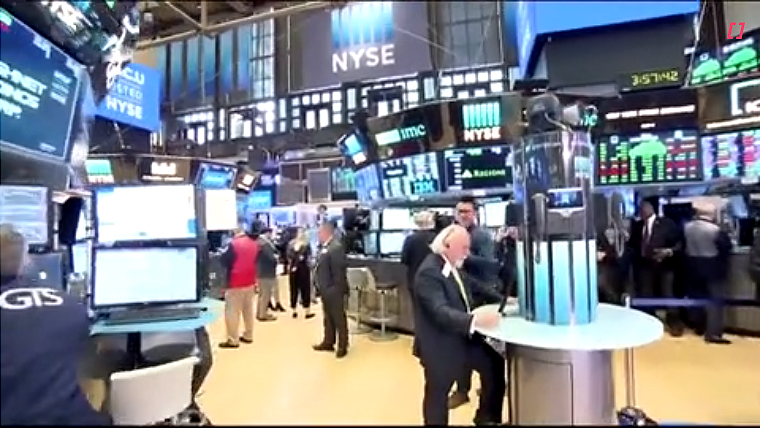
US equities are under pressure again, led by the IT sector, after the White House placed restrictions on Nvidia chip sales to China. US Treasury yields are lower for a third successive day. Net currency movements have been modest.
US equity futures were weaker in the Asian trading session after Nvidia said it would record $5.5b in writedowns in Q1, related to inventory and purchase commitments, after the US government barred the company from selling its H20 chip to China. Also not helping sentiment was a WSJ report that the US plans to use tariff negotiations to pressure US trading partners to limit their dealings with China.
Equity futures then bounced higher late in the Asian session after Bloomberg reported that China was open to trade talks if the US government showed more respect by reining in disparaging remarks by members of his cabinet. Other conditions included a more consistent US position and a willingness to address China’s concerns around American sanctions and Taiwan.
By the time the US cash market opened, the market was focused more on the negative rather than positive news. The S&P500 opened down over 1% and losses extended, with the index down over 2% with an hour left of trading. Falls in the IT sector are leading the charge lower, with Nvidia down over 8%. European markets have shown small movements, with a small loss for the Euro Stoxx 600 and a small gain for the FTSE100.
A Bloomberg article overnight has fleshed out more detail on the WSJ article noted above, adding that Trump’s top economic advisors are discussing asking representatives from other nations to impose secondary tariffs on imports from certain countries with close China ties, wanting trading partners to refrain from absorbing excess goods from China, and other concessions may also be put on the table.
In economics news, US retail sales surged 1.4% m/m in March, as expected, as consumers rushed to buy new cars ahead of the auto tariffs. There was also increased purchases of building materials, sporting goods and electronics that supported the core measures, as consumers tried to beat higher prices. Even with the front-loading of purchases, Pantheon Macroeconomics estimates annualised real consumer spending growth of just over 1% in Q1, as the year got off to a poor start, with spending likely to be just as weak or weaker in Q2.
UK CPI inflation data were on the soft side of expectations, with headline inflation falling to 2.6% y/y. Services CPI inflation, closely watched by the BoE, fell from 5.0% to 4.7%. The data encouraged the market to price in the chance of more scope for easier policy this year. A rate cut next month is now fully priced and more than three cuts for the year are priced.
Yesterday, China activity data were stronger than expected, with GDP for Q1 up 5.4% y/y and industrial production and retail sales accelerating in March to 7.7% y/y and 5.9% y/y respectively. The data were somewhat academic, with improved growth reflecting a front-loading of activity ahead of rising US import tariffs and with some added fiscal support. It’s hard to see the pick-up being sustained as the country’s exports to the US diminish towards zero, and the government will need to step up with additional stimulus measures to get anywhere near its 5% GDP target for 2025.
The Bank of Canada took a pause in the easing cycle, as widely anticipated. In a rare move, given the uncertainty around US trade policy, the Bank ditched its usual economic forecasts and instead offered two scenarios – one where tariffs are negotiated away and one of a long-lasting global trade war. Governor Macklem said the partial rollback of reciprocal tariffs moved trade policy to the middle of the two scenarios. In a wise move, the Bank offered little in terms of forward guidance on policy.
Fed Chair Powell spoke at the Economic Club of Chicago and reiterated that the central bank is in no hurry to change policy. He acknowledged that a weakening economy and elevated inflation could bring the Fed’s dual goals of maximum employment and stable prices into conflict and that the central bank would consider the economy’s distance from each goal if that scenario occurs.
US Treasury yields were in a trading range until increased selling pressure in the equity market encouraged the 10-year rate to extend lower. This is of some relief, after price action during the past week or two showed little appetite for Treasuries as a safe-haven when equities plunged. The 10-year rate now sits at 4.28%, down 6bps for the day, and down for three successive days, continuing to unwind last week’s chunky move higher in yield. The 2-year rate shows a similar movement.
In the currency market there has only been modest net movements overnight although over the last 24 hours, the USD is broadly weaker. The NZD has managed to sustain a move into the low 0.59s. The AUD is at 0.6370, with little net movement in NZD/AUD near 0.93. EUR is on the stronger side of the ledger, seeing NZD/EUR slip back to 0.52. GBP is on the weaker side of the ledger and NZD/GBP has pushed up to 0.4475.
In the domestic rates market, for a change, net market movements were modest. There was a clear flattening bias in the NZGB curve, with small increases in short-end yields and small falls in yields for the ultra-long bonds. The 10-year rate closed unchanged at 4.59%. In the swaps market the curve mildly steepened, with the 2-year rate down 3.13% and the 10-year rate up 1bp to 4.08%. The fall in the 2-year rate might have been influenced by a change in rate call from ANZ, which now sees the OCR falling to 2.5%. The OIS market showed little change in pricing for a low of around 2.7% by August.
In the day ahead, the domestic focus will be on the Q1 CPI release, with market and RBNZ estimates consistent with a lift in inflation to 0.8% q/q and 2.4% y/y. Australia’s employment report is also out, with the unemployment rate expected to tick up to 4.2%, even with a bounce-back in employment. Tonight, the ECB is widely expected to cut its policy rates by another 25bps and this is all but fully priced. There are only second-tier US economic releases, while Japan CPI data will be released on Good Friday.

We welcome your comments below. If you are not already registered, please register to comment.
Remember we welcome robust, respectful and insightful debate. We don't welcome abusive or defamatory comments and will de-register those repeatedly making such comments. Our current comment policy is here.